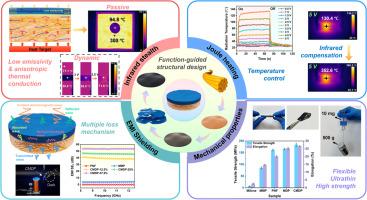Janus-structured ion-bridged MXene@PDA@PNF flexible composite films for synergistic infrared stealth, Joule thermal management, and EMI shielding
IF 14.3
1区 材料科学
Q1 MATERIALS SCIENCE, MULTIDISCIPLINARY
引用次数: 0
Abstract
With the rapid advancement of wearable electronics and the growing demand for integrated infrared stealth, electromagnetic protection, and intelligent thermal management in modern civilian and military applications, lightweight, ultrathin, flexible, and high-performance multifunctional composite materials have become a research focus. This study employs a Janus heterogeneous interface strategy to construct a spatially functional Ca2+-MXene@PDA@PNF composite film (CMDP) through the synergistic effects of biomimetic polydopamine-mediated non-covalent modification of the PNF substrate and Ca2+ bridging densification of MXene. With just 11 wt.% MXene and a thickness of 26 μm, the film achieves low infrared emissivity (ε = 0.128, 8–14 μm), high in-plane thermal conductivity (14.406 W m−1 K−1), and reduces the infrared radiation temperature of a 300°C target by 205.2°C. It exhibits rapid thermal response (t < 10 s) and wide temperature control (27.6–352.6°C) under 0.5–5 V, enabling self-adaptive dynamic infrared stealth. The film also provides excellent electromagnetic shielding (14512 dB cm2 g−1, X-band) and outstanding mechanical properties, including tensile strength (184.2 MPa), elongation at break (28.7%), and thermal stability (Td,5% = 558.1°C). These features position CMDP as a promising material for wearable infrared stealth, electromagnetic shielding, and thermal management applications.

janus结构离子桥接MXene@PDA@PNF柔性复合薄膜,用于协同红外隐身,焦耳热管理和EMI屏蔽
随着可穿戴电子技术的快速发展,以及现代民用和军事应用对集成红外隐身、电磁防护和智能热管理的需求日益增长,轻量化、超薄化、柔性化、高性能的多功能复合材料成为研究热点。本研究采用Janus异质界面策略,通过仿生多多巴胺介导的PNF底物非共价修饰和MXene的Ca2+桥接致密化的协同作用,构建了具有空间功能的Ca2+-MXene@PDA@PNF复合膜(CMDP)。MXene仅为11 wt.%,厚度为26 μm,薄膜具有较低的红外发射率(ε = 0.128,8-14 μm),较高的面内导热系数(14.406 W m−1 K−1),并将300℃目标的红外辐射温度降低了205.2℃。它在0.5-5 V下具有快速热响应(t < 10 s)和宽温度控制(27.6-352.6°C),实现自适应动态红外隐身。该薄膜还具有优异的电磁屏蔽性能(14512 dB cm2 g−1,x波段)和优异的机械性能,包括抗拉强度(184.2 MPa),断裂伸长率(28.7%)和热稳定性(Td,5% = 558.1°C)。这些特点使CMDP成为可穿戴红外隐身,电磁屏蔽和热管理应用的有前途的材料。
本文章由计算机程序翻译,如有差异,请以英文原文为准。
求助全文
约1分钟内获得全文
求助全文
来源期刊

Journal of Materials Science & Technology
工程技术-材料科学:综合
CiteScore
20.00
自引率
11.00%
发文量
995
审稿时长
13 days
期刊介绍:
Journal of Materials Science & Technology strives to promote global collaboration in the field of materials science and technology. It primarily publishes original research papers, invited review articles, letters, research notes, and summaries of scientific achievements. The journal covers a wide range of materials science and technology topics, including metallic materials, inorganic nonmetallic materials, and composite materials.
 求助内容:
求助内容: 应助结果提醒方式:
应助结果提醒方式:


